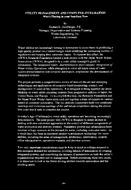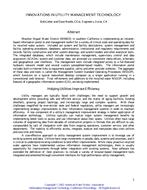Provide PDF Format
AWWA JAW62060
- Journal AWWA - Red Water Release In Drinking Water Distribution Systems
- Journal Article by American Water Works Association, 09/01/2005
- Publisher: AWWA
$15.00$30.00
With the implementation of groundwater conservationmeasures, many utilities with a historical relianceon groundwater sources have been obligated to consideralternative sources to augment their supplies oreliminate their groundwater dependence. Switchingfrom traditional source water, however, can bringabout unacceptable changes in water quality resultingfrom destabilization and release of chemical and biologicalfilms from the interior surfaces of the existingdistribution systems. For example, red water release indistribution systems is caused by the release of corrosionproducts from unlined- and galvanized-iron pipes.In this two-year study, the effect of changing waterquality on red water release in distribution systemswas evaluated under a wide range of conditions tosimulate blending of different source waters (groundwater,surface water, and desalinated water). First,investigators identified alkalinity, chlorides, sulfates,sodium, dissolved oxygen, temperature, and hydraulicretention time (HRT) as significant water quality parameters.Next, a predictive nonlinear model was developedto estimate the corrosivity of blends based onwater quality.The results of the statistical analysis indicate thatalkalinity, chlorides, sulfates, sodium, and dissolvedoxygen of the source water or blend of source watershave a significant effect on release of corrosion byproductsin the form of red water. Alkalinity has astrong negative correlation to increase in color, butchlorides, sulfates, sodium, dissolved oxygen, temperature,and HRT showed a positive correlation toincrease in color. Temperature and HRT were the significantphysical and operational parameters identified.This work resulted in a valuable tool for evaluatingrelease problems resulting from different blendsof water. Includes 13 references, tables, figures.
Related Products
AWWA WQTC62387
A Pilot Study on Fouling of Immersed Membranes by Natural Organic Matter..
$12.00 $24.00
AWWA CSC95022
Utility Management and Computer Integration: Who's Playing in Your Sandbox Now..
$12.00 $24.00





